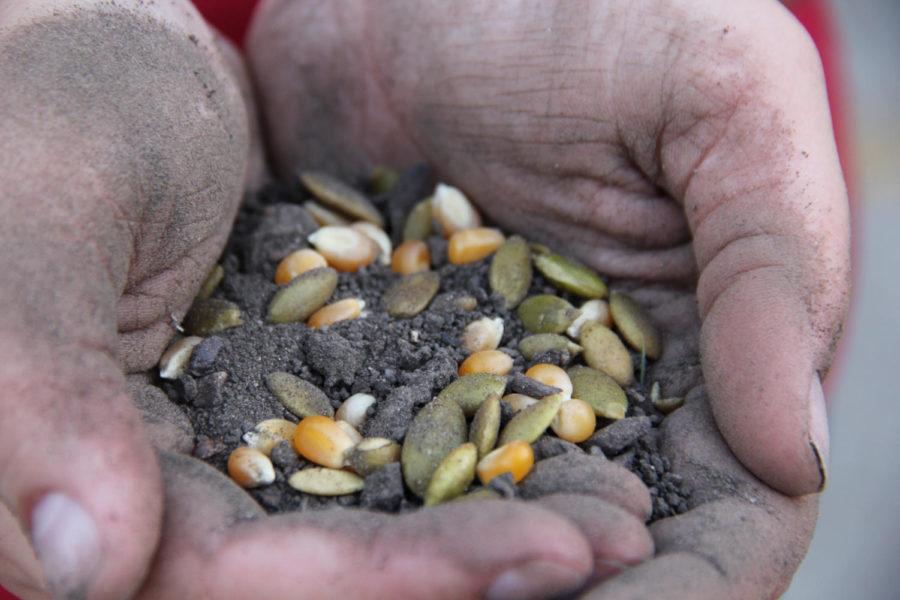Daily: Seed saving for better taste, nutrition, future
Jonathan Krueger/Iowa State Daily
Plants such as tomatoes are maintained through seed saving and open-pollination.
August 28, 2013
Have you ever tasted a tomato? I mean really tasted one — felt the pulpy, sweet, subtly acidic juice run over your tongue.
I used to hate tomatoes. But the tomatoes I hated were anemic, often devoid of color and flavor, especially when they were out of season. But if you, like me, have discovered the joys of biting into a sun-ripened, garden-grown tomato in the summertime, you know just how much potential a simple tomato has.
If you have enjoyed a tomato like this, it was probably home grown or possibly a less common heirloom variety. Heirloom varieties are old cultivars of seeds grown and maintained by gardeners on a small scale. Heirloom varieties are maintained through seed saving and open-pollination, which means that the plants are pollinated by natural mechanisms such as the air, birds and bees.
These seeds are not used in large-scale agriculture and heirloom varieties as well as open-pollination are often disdained by large agribusinesses. But there are several reasons why seed saving should be supported to maintain heirloom varieties.
The first reason why seed saving and heirloom crops are important is biodiversity. While pesticides and genetically modified organisms can be good methods to growing a crop resistant to certain pests, they are not environmentally sound solutions. Planting a variety of crops (such as several soy or corn cultivars) promotes biodiversity and allows different crops to be grown for different characteristics. This also allows growers to plant a variety of crops that are resistant to drought or pests, grow brilliant colors and have specific tastes.
Unfortunately, many agribusinesses in the United States have actually worked to outlaw seed saving, for example, Monsanto. You can learn more about this in the corn business from the documentary “King Corn.” Even today, farmers’ fights with agribusinesses have gone all the way to the Supreme Court, which is covered and explained in this story on “David v. Goliath.”
Luckily, scientists are looking towards the future. Seeds banks, essentially vaults with many seed varieties, are being supported all over the world. For example, a Doomsday Vault was created in Norway to save over 2 billion plant species. Other seed vaults across the country and around the globe are opening up and saving seeds. Organizations like the Seed Savers Exchange bring together gardeners all over the world to collect and exchange heirloom seeds. Programs like this are necessary to ensure the stability of crops in the future.
Not only does saving seeds protect biodiversity and rich cultural and historical crops, its heirloom varieties offer more nutritional value and flavor. As mentioned earlier, tomatoes have a lot of potential for crazy colors and great flavors. Tomato seeds are easier to save than some other seeds, can be crossbred with other varieties and have wide spectrum of colors and tastes.
This story from NPR, “How A Seed Saver Discovered One Of Our Favorite Tomatoes,” tells the tale of how one seed saver from North Carolina introduced the world to the Cherokee Purple tomato, one of the most popular heirloom varieties sold today. His story is encouraging because it shows the potential of seed saving — sharing great tastes and preserving cultural histories.
Another story published this week by NPR, “Reviving An Heirloom Corn That Packs More Flavor and Nutrition,” talks about the success of heirloom corn being served at the Blue Hill restaurant in the Hudson River Valley. This story is another great example of how seed savers and gardeners work together to promote plants with more flavor and nutrition. The prevalence of stories such as these just goes to show the growing importance of seed saving in agriculture.
To learn more about the effects of monoculture, environmental activism and other issues related to seed saving, I highly recommend the following two works of fiction: “All Over Creation,” by Ruth Ozeki, and “The Windup Girl,” by Paolo Bacigalupi. Though works of fiction, these pieces offer amazing insight into these agricultural issues.
Perhaps the most enticing argument for heirloom varieties for the common consumer is that they almost always taste better and are often better for you.

















